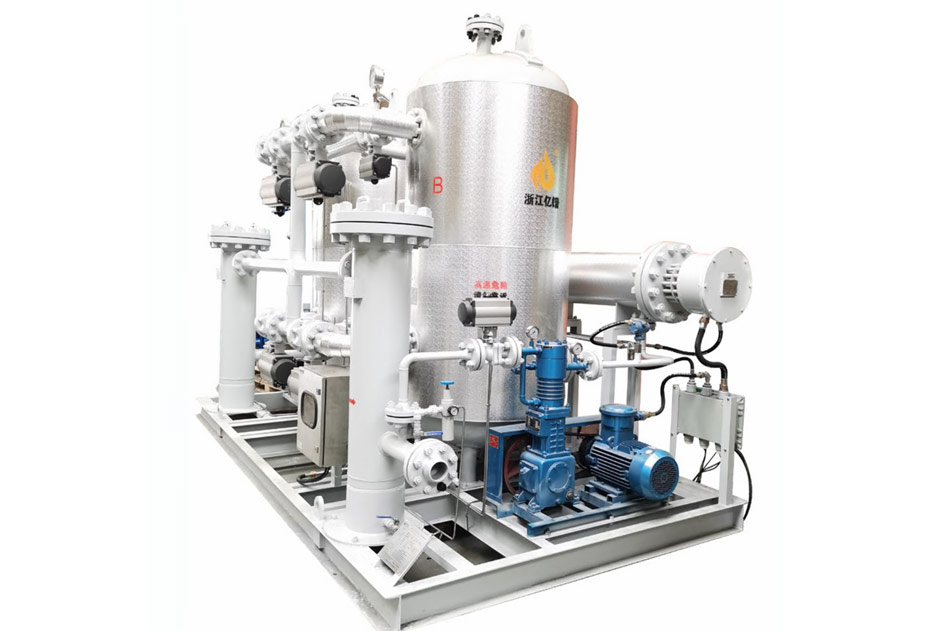Offshore Oilfield Natural Gas Dehydration Solutions
Industry Pain Points
High Humidity and Salt Spray Corrosion: The water content of offshore natural gas exceeds 90%, and it contains salt (Cl⁻ concentration ≥500ppm). This results in a corrosion rate of pipelines and compressors three times higher than that on land, with annual maintenance costs of offshore platforms exceeding 20 million yuan.
Space and Load-Bearing Constraints: The area of offshore platforms is only 1/5 of that of onshore facilities. Traditional TEG dehydration systems occupy too much space and exceed the deck load standard (requiring ≤15 tons per module).
Unstable Energy Supply: Offshore platforms rely on gas turbines for power, with frequent fluctuations (voltage ±10%), leading to a 25% failure rate of electrically driven dehydration equipment.
Strict Environmental Regulations: The International Maritime Organization (IMO) requires the oil content in offshore discharged water to be ≤15ppm, which traditional chemical dehydrating agents struggle to meet.
System Overview
Through the “hypergravity desalination – salt-tolerant adsorption – vortex regeneration” technology loop, Yipu Offshore Oilfield Dehydration System achieves:
- Zero Power Dependence: 100% utilization of wellhead pressure energy, adapting to the world’s harshest offshore environments.
- Extreme Space Optimization: A single module has a treatment capacity of up to 300,000 Nm³/day, with a weight only 60% of that of competitors.
- Full-Life-Cycle Compliance: Fully meets international standards such as IMO and DNV in terms of both dehydration performance and drainage environmental protection.
Solution Approach
Yipu Offshore Oilfield Natural Gas Dehydration Solution
| Module | Technical Highlights | Performance Parameters |
|---|---|---|
| Salt-Resistant Separator | Titanium alloy material + nanoscale hydrophobic coating | Liquid droplet removal rate ≥99%, pressure loss ≤0.003MPa |
| Compact Adsorption Tower | Carbon fiber-wound shell, weight only 8 tons per module | Dew point -60℃, floor space 3m² |
| Vortex Regeneration System | Pressure energy conversion efficiency ≥75%, zero external power supply | Regeneration energy consumption ≤0.02kWh/Nm³ |
| Intelligent Drainage | Membrane-based oil-water separation, oil content in discharged water ≤5ppm | Complies with IMO 2023 standards |
| Typhoon-Resistant Design | Overall earthquake resistance (Grade 8), corrosion-resistant service life ≥15 years | Certified by DNV GL |
Applicable Scenarios:
- Central processing platforms for deep-sea gas fields
- FPSO (Floating Production, Storage and Offloading) units
- Instant dehydration at wellheads of marginal oilfields
Technical Principles
Yipu Three-Stage Salt-Resistant Dehydration Process:
- Cyclonic Liquid Removal (Stage 1):The titanium alloy hypergravity separator generates 800G centrifugal force within 0.2 seconds, removing 98% of free water and salt spray, and adapting to Cl⁻ ≤1000ppm.
- Salt-Tolerant Adsorption (Stage 2):Hydrophobic zeolite – molecular sieve composite bed:
- Zeolite prioritizes salt adsorption (NaCl removal rate ≥95%)
- Molecular sieves have a service life of 5 years in salt spray environments
- Self-Heating Regeneration (Stage 3):Uses wellhead natural gas pressure energy to drive the vortex heater, realizing adsorbent regeneration (180℃) without electricity consumption.
Core Advantage
| Advantage | Details |
|---|---|
| Customized on Demand | Meets special working conditions; provides professional non-standard customization |
| Low Cost | Adopts cyclic regeneration process; significantly reduces operating costs |
| High Stability | Dual-tower structure with small pressure fluctuation; low noise and continuous gas supply |
| Fully Automatic Operation | Easy to operate, reducing labor input; improves efficiency |
| High Safety | Presets multi-level safety protection measures; supports automatic alarm |
| Low Failure Rate | Maintains low failure rate after 10,000 hours; high durability with almost no maintenance required |
Technical Strength
Leading Adsorption Dehydration Technology
Uses high-performance molecular sieve adsorbents with high water absorption capacity and resistance to corrosion by acidic gases (H₂S/CO₂), ensuring deep dehydration with a dew point ≤-70℃.
The original hot nitrogen regeneration process reduces energy consumption by 30% compared with traditional electric heating regeneration, and integrates a waste heat recovery system to significantly improve energy efficiency.
Modular and Customized Design Capability
Core equipment adopts modular prefabrication, supporting rapid deployment (installation cycle shortened by 50%) and adapting to diverse scenarios such as offshore platforms, onshore gas fields, and LNG pretreatment.
Can customize single-tower, dual-tower, or multi-tower parallel systems according to customer needs, with a treatment capacity ranging from 10,000 to 1,000,000 Nm³/d, flexibly matching gas fields of different scales.
Intelligent Control and Remote Operation & Maintenance
Equipped with a PLC+IoT intelligent control system, it real-time monitors key parameters such as pressure, temperature, and dew point, supporting fault early warning and automatic adjustment.
Through cloud-based big data analysis, it optimizes the adsorption-regeneration cycle, extends the service life of molecular sieves, and reduces operation and maintenance (O&M) costs by 10%-15%.
Energy-Saving and Environmental Protection Technology
Features zero-emission design for regeneration exhaust gas, complying with international environmental standards such as EU CE and US EPA.
Energy consumption is 25%-40% lower than that of traditional triethylene glycol (TEG) dehydration systems, helping customers achieve carbon emission reduction goals.
Long-Cycle Operation Reliability
Molecular sieves adopt anti-pulverization coating technology, with a service life of over 5 years, reducing replacement frequency.
Key components (e.g., valves, instruments) are selected from international first-tier brands (e.g., Siemens, Emerson), with a Mean Time Between Failures (MTBF) of over 100,000 hours.
Strong R&D and Engineering Experience
Possesses more than 19 patents and software copyrights in dehydration technology; the R&D team is led by doctors and has in-depth cooperation with universities and colleges.
Has over 1,000 successful cases worldwide, covering extreme working conditions such as high-sulfur gas fields in the Middle East and low-temperature environments in the Arctic.
Product Advantage Comparison
| Indicator | Yipu System | TEG Dehydration | Onshore Molecular Sieve | Competitor Offshore Systems |
|---|---|---|---|---|
| Dew Point | -60℃ (normal state) | -30℃ (requires deep regeneration) | -40℃ (fails in 1 year under salt spray) | -50℃ (30% overweight) |
| Energy Consumption | 0.03kWh/Nm³ (including cold energy recovery) | 0.15kWh/Nm³ | 0.12kWh/Nm³ | 0.1kWh/Nm³ |
| Salt Resistance | No corrosion at Cl⁻≤1000ppm | Requires pre-desalination | Fails at Cl⁻≥200ppm | Cl⁻≤500ppm |
| Weight/Floor Space | 8 tons / 3m² | 25 tons / 10m² | 15 tons / 6m² | 12 tons / 5m² |
| Environmental Friendliness | Zero chemicals, oil content in discharged water ≤5ppm | Risk of benzene-series compound emissions | Difficult molecular sieve waste disposal | Chemicals require shipping by vessel |
Typical Case
Project Name: FPSO Renovation in a Deepwater Gas Field in the South China Sea
Operating Conditions:
- Treatment Capacity: 800,000 Nm³/day, pressure 5-12MPa
- Water Quality: Cl⁻ 800ppm, H₂S 300ppm
Dehydration Effect:
- Dew point reduced from saturated state to -65℃
- Dehydration system weight reduced by 55 tons, saving 40% of deck space
Economic Benefits:
- Reduced annual corrosion maintenance costs by 18 million yuan
- Eliminated 5 million yuan in annual chemical shipping costs

